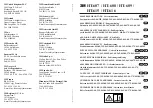
18
use and maintenance
Rally 50
-
"!3)# 3!&%49 25,%3
The instructions given below cover normal
operation of your vehicle and must be
carefully observed. By following these
rules you will enhance your own safety and
the safety of those around you. You will
also maximize the life and utility of your ve-
hicle.
Two wheeled vehicles obviously do not
provide some of the protection provided by
automobiles, therefore it is essential that
you wear appropriate protective clothing.
Especially, never operate your vehicle
without wearing your helmet, gloves, eye
protection, a heavy jacket, sturdy footwear,
and sturdy full length pants.
However, do not assume that even the
best clothing and helmet will protect you in
the event of an upset or a crash with anoth-
er vehicle. At best, this gear provides
some protection from scrapes and scratch-
es, but very little, if any, impact protection.
Be sure that you meet all the requirements
prescribed by local law, including driver’s li-
cense, minimum age, training, insurance,
taxes, vehicle registration, license plate,
etc.
When you first receive your vehicle, prac-
tice by riding in areas where there is little
traffic. Do not attempt to ride in heavy traf-
fic until you are thoroughly experienced
and riding your vehicle has become sec-
ond nature to you.
Most states prohibit the operation of this
size vehicle on freeways or expressways,
be sure that it is legal to use your vehicle
before you take any particular road.
A new vehicle must be carefully broken in,
see p. 50 (RUNNING-IN).
Before starting the engine, make sure that
the brakes, clutch, transmission and throt-
tle controls function properly and that the
fuel and oil supply is adequate.
The exhaust system, brakes, and some
other parts of the vehicle become very hot
during operation. Do not touch any of
these parts.
Some medicines or drugs, illegal or pre-
scription, and alcohol significantly increase
the risk of accidents. Do not ride while you
are under the influence of alcohol or drugs,
be they illicit or prescription. Make sure
you are in good physical condition and not
ill before riding your vehicle. Do not ride
your vehicle when you are particularly tired
or fatigued. Alcohol, drugs and fatigue are
leading causes of vehicle accidents.
Many accidents are caused by the rider’s
inexperience and lack of training. Do not
ride your vehicle until you have received
training from a recognized training organi-
zation such as the Motorcycle Safety
Foundation. Remember that riding a vehi-
cle, though easy and fun, is quite different
from driving a car. Do not assume that you
can operate your vehicle safely just be-
cause you are a competent automobile
driver.
Never lend your vehicle to others unless
you are sure that they are competent and
properly licensed vehicle operators.
Summary of Contents for RALLY 50
Page 1: ......
Page 8: ...8 use and maintenance Rally 50 0 3 4 4 7 2 3 6 3 ...
Page 10: ...10 use and maintenance Rally 50 9 10 11 Ref Description 12 13 14 Ref Description ...
Page 17: ...safe drive ...
Page 96: ...96 use and maintenance Rally 50 MPORTERS ...
Page 97: ...97 use and maintenance Rally 50 MPORTERS ...
Page 98: ...98 use and maintenance Rally 50 7 2 2 2ALLY ...
Page 100: ...100 4 3 2 5 30 2 0 243 9 use and maintenance Rally 50 ...
Page 101: ...101 4 3 2 5 30 2 0 243 9 use and maintenance Rally 50 ...
Page 102: ...102 4 3 2 5 30 2 0 243 9 use and maintenance Rally 50 ...
Page 103: ...103 4 3 2 5 30 2 0 243 9 use and maintenance Rally 50 ...
















































